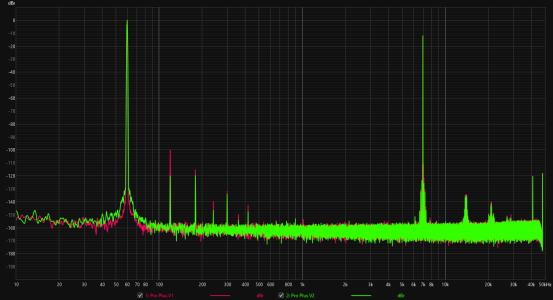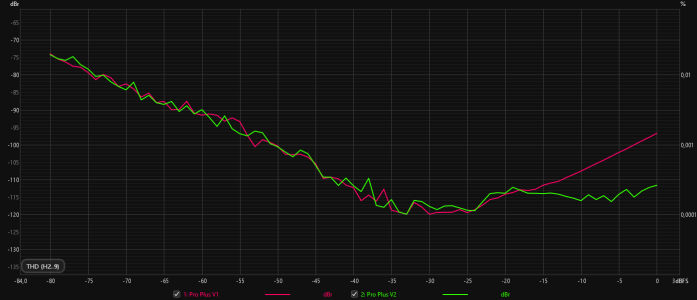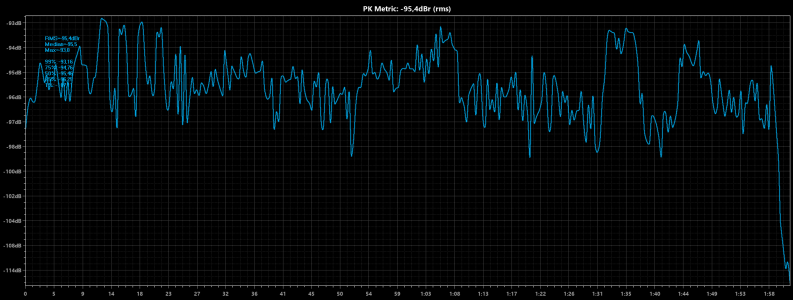Note: due to the fact that my sample unit had significant problems with various PSUs and this was fixed with the FW update, the entire post has been corrected and updated with the most up-to-date measurements.
As you can see I finally got the second sample of the Pro Plus with promised improvements of measurements, especially in low frequencies. Time to find out what has changed.
I will use mostly the same gear as before. The biggest change is an introduction of the Cosmos Scaler, a buffer with variable gain to help get more precise results in stepped measurements. And to attenuate the impact of ESS hump for ADC Cosmos.
The second change is using Sbooster LPS as the main PSU for measurements as I believe that using such kind of power supply units is the most common path of upgrade in the "audiophiles" world.
My methodology will differ a bit. This time I'm gonna use also DeltaWave software to investigate an impact of different interconnect cables as well as power sources.
At the moment just one graph to show distortions vs frequency for -3 dBFS sweep signal:

As both units behave very similar in many aspects (for example output voltage levels) I will focus on differences only.
Both units were powered by Sbooster LPS unless otherwise noted, with the analog output level set to 2 Vrms.
I suggest to look here for details on previous measurements of the first unit:
 forum.wiimhome.com
forum.wiimhome.com
FFT single measurements
Visible advantage in multitone measurement:

Reduced second harmonics level gives slightly better results with 1 kHz sine wave:

SINAD increases by 3 dB from 112.8 to 115.8. Dynamic range keeps the same level in range 118.9 - 119.1 dB.
As improvements are mainly for low frequencies, differences are clearly visible in the SMPTE test for IMD / low frequency distortions:

IMD reduced from -93.6 dB to -105.5 dB. TD+N reduced from -99.6 dB to -112 dB.
FFT stepped tests
The THD curve as a function of signal level has changed, below for a 40 Hz sine wave signal:

And for 1 kHz:

IMD level based on the SMPTE test:

All level tests confirm the promised improvement over the first version of Pro Plus.
One remark on plots vs level - distortion values are in dB (Y-axis) relative to the fundamental dBFS level (X-axis).
The THD curve as a function of frequency confirms what we have seen with the sweep signal. This one is for 0 dBFS signal level:

Comparisons in the time domain
As pure FFT measurements are boring already, time for something different - combining FFT analysis with time related sample matching.
Let me introduce DeltaWave Audio Null Comparator:
Using this tool I will provide delta audio files for different RCA cable / PSU combinations between both Pro Plus units. In case of cables I will include Mogami 2534 RCA-XLR cable, Mogami 2964 RCA, a stock one included with the Plus and a bit weird Douk Audio / Nobsound RCA with high 900 pF/m capacitance. As a power source I will use Sbooster LPS, Allo Nirvana SMPS, Xiaomi powerbank and the Plus' stock charger.
The reference audio file will be "this wav file evaluated by means of Audio DiffMaker":

First batch: WiiM Pro Plus "PCB-3", WiFi, Sbooster, left channel differences - cables
 drive.google.com
drive.google.com
And second batch: WiiM Pro Plus "PCB-3", WiFi, Mogami 2534, left channel differences - power sources
 drive.google.com
drive.google.com
In my opinion, replacing the mentioned analog interconnects or power sources does not produce any audible effect. The differences generated in the form of delta files are not large enough to affect audibility.
DeltaWave introduces PK Metric measure which is designed to be perceptually-weighted over time, kind of a synthetic metric to evaluate the audibility of captured differences. Further details are available here:

 www.audiosciencereview.com
www.audiosciencereview.com
The worst measured PKEM for different cables was as below

and for PSUs

while audibility for results close to -60 dB or a bit higher is "debatable".
Finally, there is an audibility comparison between the 2 Plus revisions. The same setup - Sbooster, WiFi, Mogami 2534, 2Vrms output, no EQ, fast linear phase filter, etc.
 drive.google.com
drive.google.com
The measured PKEM is as below

and it will be even lower when sound level matching is applied

Based on that (and previous measurements) I would stay on the position that it's unlikely to hear differences between these 2 revisions.
As you can see I finally got the second sample of the Pro Plus with promised improvements of measurements, especially in low frequencies. Time to find out what has changed.
I will use mostly the same gear as before. The biggest change is an introduction of the Cosmos Scaler, a buffer with variable gain to help get more precise results in stepped measurements. And to attenuate the impact of ESS hump for ADC Cosmos.
The second change is using Sbooster LPS as the main PSU for measurements as I believe that using such kind of power supply units is the most common path of upgrade in the "audiophiles" world.
My methodology will differ a bit. This time I'm gonna use also DeltaWave software to investigate an impact of different interconnect cables as well as power sources.
At the moment just one graph to show distortions vs frequency for -3 dBFS sweep signal:

As both units behave very similar in many aspects (for example output voltage levels) I will focus on differences only.
Both units were powered by Sbooster LPS unless otherwise noted, with the analog output level set to 2 Vrms.
I suggest to look here for details on previous measurements of the first unit:
My WiiM Pro Plus (+) tests
At a moment I can tell that my sample unit has an increased space around the coax socket. And a glossy finish of the chassis. Stay tuned :) Part 0 - a test gear possibly involved RME ADI-2 DAC FS, ESS edition miniDSP Flex, RCA edition E1DA Cosmos ADC, A grade PicoScope 4444 Intona 7055-D...
FFT single measurements
Visible advantage in multitone measurement:

Reduced second harmonics level gives slightly better results with 1 kHz sine wave:

SINAD increases by 3 dB from 112.8 to 115.8. Dynamic range keeps the same level in range 118.9 - 119.1 dB.
As improvements are mainly for low frequencies, differences are clearly visible in the SMPTE test for IMD / low frequency distortions:

IMD reduced from -93.6 dB to -105.5 dB. TD+N reduced from -99.6 dB to -112 dB.
FFT stepped tests
The THD curve as a function of signal level has changed, below for a 40 Hz sine wave signal:

And for 1 kHz:

IMD level based on the SMPTE test:

All level tests confirm the promised improvement over the first version of Pro Plus.
One remark on plots vs level - distortion values are in dB (Y-axis) relative to the fundamental dBFS level (X-axis).
The THD curve as a function of frequency confirms what we have seen with the sweep signal. This one is for 0 dBFS signal level:

Comparisons in the time domain
As pure FFT measurements are boring already, time for something different - combining FFT analysis with time related sample matching.
Let me introduce DeltaWave Audio Null Comparator:
Using this tool I will provide delta audio files for different RCA cable / PSU combinations between both Pro Plus units. In case of cables I will include Mogami 2534 RCA-XLR cable, Mogami 2964 RCA, a stock one included with the Plus and a bit weird Douk Audio / Nobsound RCA with high 900 pF/m capacitance. As a power source I will use Sbooster LPS, Allo Nirvana SMPS, Xiaomi powerbank and the Plus' stock charger.
The reference audio file will be "this wav file evaluated by means of Audio DiffMaker":

Original2
MediaFire is a simple to use free service that lets you put all your photos, documents, music, and video in a single place so you can access them anywhere and share them everywhere.
www.mediafire.com
First batch: WiiM Pro Plus "PCB-3", WiFi, Sbooster, left channel differences - cables
plus_v2_sbooster_wifi – Google Drive
 drive.google.com
drive.google.com
And second batch: WiiM Pro Plus "PCB-3", WiFi, Mogami 2534, left channel differences - power sources
plus_v2_mogami-2534_wifi – Google Drive
 drive.google.com
drive.google.com
In my opinion, replacing the mentioned analog interconnects or power sources does not produce any audible effect. The differences generated in the form of delta files are not large enough to affect audibility.
DeltaWave introduces PK Metric measure which is designed to be perceptually-weighted over time, kind of a synthetic metric to evaluate the audibility of captured differences. Further details are available here:

PK Error Metric discussion and beta-test
As many of you know, I created DeltaWave app for null-type differencing comparisons between two audio files: reference and comparison. I'd like to propose a new error metric that I just added to DeltaWave. Due to a complete lack of product naming skills, I'm calling it the PK Error Metric:)The...
 www.audiosciencereview.com
www.audiosciencereview.com
The worst measured PKEM for different cables was as below

and for PSUs

while audibility for results close to -60 dB or a bit higher is "debatable".
Finally, there is an audibility comparison between the 2 Plus revisions. The same setup - Sbooster, WiFi, Mogami 2534, 2Vrms output, no EQ, fast linear phase filter, etc.
plus_v1_v2 – Google Drive
 drive.google.com
drive.google.com
The measured PKEM is as below

and it will be even lower when sound level matching is applied

Based on that (and previous measurements) I would stay on the position that it's unlikely to hear differences between these 2 revisions.
Last edited:


